Urban Rail Transit in Bangkok: Chronological Development Review and Impact on Residential Property Value
Abstract
:1. Introduction
2. Chronological Review of Urban Rail Transit Development in Bangkok
2.1. Urban Rail Transit Planning and Development
2.2. Land Value Appreciation along the Urban Rail Corridors
3. Analysis on Impact of Rail Transit Development
3.1. Literature Review
3.1.1. Property Value Uplift
3.1.2. Hedonic Pricing Model
3.1.3. Model with Spatial Effects
3.2. Data
3.3. Model Specification
3.4. Results
3.4.1. OLS Model Results
3.4.2. MGWR Model Results
4. Discussion
4.1. Unorganized Urban and Rail Transit Development
4.2. Spatially Varying Impact on Residential Property Value Uplift
4.3. Polycentric Development
4.4. Walkability in the TOD Environment
5. Concluding Remarks
Author Contributions
Funding
Institutional Review Board Statement
Informed Consent Statement
Conflicts of Interest
References
- Bank, A.D. Asian Development Outlook 2019 Update: Fostering Growth and Inclusion in Asia’s Cities; Asian Development Bank: Manila, Philippines, 2019. [Google Scholar]
- Abiad, A.; Farrin, K.; Hale, C. Sustaining Transit. Investment in Asia’s Cities: A Beneficiary-Funding and Land Value Capture Perspective; Asian Development Bank: Manila, Philippines, 2019. [Google Scholar]
- Bhu-Anantanondh, N.; Kanyajit, S.; Suwannanon, A.; Sinloyma, P. Solving Bangkok’s Traffic Problems. Cosmop. Civ. Soc. Interdiscip. J. 2021, 13, 46–61. [Google Scholar] [CrossRef]
- Achariyaviriya, W.; Hayashi, Y.; Takeshita, H.; Kii, M.; Vichiensan, V.; Theeramunkong, T. Can Space–Time Shifting of Activities and Travels Mitigate Hyper-Congestion in an Emerging Megacity, Bangkok? Effects on Quality of Life and CO2 Emission. Sustainability 2021, 13, 6547. [Google Scholar] [CrossRef]
- Vichiensan, V.; Malaitham, S.; Miyamoto, K. Hedonic Analysis of Residential Property Values in Bangkok: Spatial Dependence and Nonstationarity Effects. J. East. Asia Soc. Transp. Stud. 2011, 9, 886–899. [Google Scholar] [CrossRef]
- Malaitham, S.; Fukuda, A.; Vichiensan, V.; Wasuntarasook, V. Hedonic pricing model of assessed and market land values: A case study in Bangkok metropolitan area, Thailand. Case Stud. Transp. Policy 2020, 8, 153–162. [Google Scholar] [CrossRef]
- Kocks, K.F. Bangkok Transportation Study (BTS). Final Report; Thai-German Technical Cooperation: Bangkok, Thailand, 1975. [Google Scholar]
- Japan International Cooperation Agency (JICA). Preliminary Study on an Improvement Plan for Railway Transport in and around the Bangkok Metropolis in Consideration of Urban Development in the Kingdom of Thailand; JICA: Bangkok, Thailand, 1992.
- Japan International Cooperation Agency (JICA). The Study on an Improvement Plan for Railway Transport in and around the Bangkok Metropolis in Consideration of Urban Development in the Kingdom of Thailand, Final Report; JICA: Bangkok, Thailand, 1995.
- Office of Transport and Traffic Policy and Planning. Mass Rapid Transit Master Plan in Bangkok Metropolotan Region: M-MAP; Office of Transport and Traffic Policy and Planning: Bangkok, Thailand, 2010.
- Japan International Cooperation Agency (JICA). Data Collection Survey on the Development of Blueprint for the Second Mass Rapid Transit. Master Plan. (M-Map2) in The Kingdom of Thailand; JICA: Bangkok, Thailand, 2019.
- Cuthill, N.; Cao, M.; Liu, Y.; Gao, X.; Zhang, Y. The Association between Urban Public Transport Infrastructure and Social Equity and Spatial Accessibility within the Urban Environment: An Investigation of Tramlink in London. Sustainability 2019, 11, 1229. [Google Scholar] [CrossRef] [Green Version]
- Lee, J.; Boarnet, M.; Houston, D.; Nixon, H.; Spears, S. Changes in Service and Associated Ridership Impacts near a New Light Rail Transit Line. Sustainability 2017, 9, 1827. [Google Scholar] [CrossRef] [Green Version]
- Cervero, R.; Landis, J. Twenty years of the Bay Area Rapid Transit system: Land use and development impacts. Transp. Res. Part A Policy Pract. 1997, 31, 309–333. [Google Scholar] [CrossRef]
- Zhao, L.; Shen, L. The impacts of rail transit on future urban land use development: A case study in Wuhan, China. Transp. Policy 2019, 81, 396–405. [Google Scholar] [CrossRef]
- Alquhtani, S.; Anjomani, A. Do Rail Transit Stations Affect the Population Density Changes around Them? The Case of Dallas-Fort Worth Metropolitan Area. Sustainability 2021, 13, 3355. [Google Scholar] [CrossRef]
- Sekasi, J.; Martens, M.L. Assessing the Contributions of Urban Light Rail Transit to the Sustainable Development of Addis Ababa. Sustainability 2021, 13, 5667. [Google Scholar] [CrossRef]
- Andrade, C.; D’Agosto, M. The Role of Rail Transit Systems in Reducing Energy and Carbon Dioxide Emissions: The Case of The City of Rio de Janeiro. Sustainability 2016, 8, 150. [Google Scholar] [CrossRef] [Green Version]
- Zhang, X.; Liu, X.; Hang, J.; Yao, D.; Shi, G. Do Urban Rail Transit Facilities Affect Housing Prices? Evidence from China. Sustainability 2016, 8, 380. [Google Scholar] [CrossRef] [Green Version]
- Pan, H.; Zhang, M. Rail Transit Impacts on Land Use: Evidence from Shanghai, China. Transp. Res. Rec. J. Transp. Res. Board 2008, 2048, 16–25. [Google Scholar] [CrossRef]
- Dziauddin, M.F. Estimating land value uplift around light rail transit stations in Greater Kuala Lumpur: An empirical study based on geographically weighted regression (GWR). Res. Transp. Econ. 2019, 74, 10–20. [Google Scholar] [CrossRef]
- Vichiensan, V.; Miyamoto, K. Influence of Urban Rail Transit on House Value: Spatial Hedonic Analysis in Bangkok. J. East. Asia Soc. Transp. Stud. 2010, 8, 986–996. [Google Scholar]
- Anantsuksomsri, S.; Tontisirin, N. The Impacts of Mass Transit Improvements on Residential Land Development Values: Evidence from the Bangkok Metropolitan Region. Urban. Policy Res. 2015, 33, 195–216. [Google Scholar] [CrossRef]
- Chalermpong, S. Rail Transit and Residential Land Use in Developing Countries: Hedonic Study of Residential Property Prices in Bangkok, Thailand. Transp. Res. Rec. J. Transp. Res. Board 2007, 2038, 111–119. [Google Scholar] [CrossRef]
- Welch, T.F.; Gehrke, S.R.; Wang, F. Long-term impact of network access to bike facilities and public transit stations on housing sales prices in Portland, Oregon. J. Transp. Geogr. 2016, 54, 264–272. [Google Scholar] [CrossRef]
- Hess, D.B.; Almeida, T.M. Impact of Proximity to Light Rail Rapid Transit on Station-area Property Values in Buffalo, New York. Urban. Stud. 2007, 44, 1041–1068. [Google Scholar] [CrossRef]
- Song, Z.; Cao, M.; Han, T.; Hickman, R. Public transport accessibility and housing value uplift: Evidence from the Docklands light railway in London. Case Stud. Transp. Policy 2019, 7, 607–616. [Google Scholar] [CrossRef]
- Brandt, S.; Maennig, W. The impact of rail access on condominium prices in Hamburg. Transportation 2012, 39, 997–1017. [Google Scholar] [CrossRef]
- Martínez, L.M.; Viegas, J.M. Effects of Transportation Accessibility on Residential Property Values. Transp. Res. Rec. 2009, 2115, 127–137. [Google Scholar] [CrossRef]
- Li, Q.; Wang, J.; Callanan, J.; Lu, B.; Guo, Z. The spatial varying relationship between services of the train network and residential property values in Melbourne, Australia. Urban. Stud. 2020, 58, 335–354. [Google Scholar] [CrossRef]
- Ryan, S. The Value of Access to Highways and Light Rail Transit: Evidence for Industrial and Office Firms. Urban. Stud. 2005, 42, 751–764. [Google Scholar] [CrossRef] [Green Version]
- Du, H.; Mulley, C. Relationship Between Transport Accessibility and Land Value: Local Model Approach with Geographically Weighted Regression. Transp. Res. Rec. J. Transp. Res. Board 2006, 1977, 197–205. [Google Scholar] [CrossRef]
- Hewitt, C.M.; Hewitt, W.E.T. The effect of proximity to urban rail on housing prices in Ottawa. J. Public Transp. 2012, 15, 43–65. [Google Scholar] [CrossRef]
- Forouhar, A.; Van Lierop, D. If you build it, they will change: Evaluating the impact of commuter rail stations on real estate values and neighborhood composition in the Rotterdam–The Hague metropolitan area, The Netherlands. J. Transp. Land Use 2021, 14, 949–973. [Google Scholar] [CrossRef]
- Berawi, M.A.; Miraj, P.; Saroji, G.; Sari, M. Impact of rail transit station proximity to commercial property prices: Utilizing big data in urban real estate. J. Big Data 2020, 7, 71. [Google Scholar] [CrossRef]
- Bae, C.-H.C.; Jun, M.-J.; Park, H. The impact of Seoul’s subway Line 5 on residential property values. Transp. Policy 2003, 10, 85–94. [Google Scholar] [CrossRef]
- Chen, Y.; Yazdani, M.; Mojtahedi, M.; Newton, S. The impact on neighbourhood residential property valuations of a newly proposed public transport project: The Sydney Northwest Metro case study. Transp. Res. Interdiscip. Perspect. 2019, 3, 100070. [Google Scholar] [CrossRef]
- Kawamura, K.; Mahajan, S. Hedonic Analysis of Impacts of Traffic Volumes on Property Values. Transp. Res. Rec. 2005, 1924, 69–75. [Google Scholar] [CrossRef]
- Shin, K.; Washington, S.; Choi, K. Effects of Transportation Accessibility on Residential Property Values: Application of Spatial Hedonic Price Model in Seoul, South Korea, Metropolitan Area. Transp. Res. Rec. J. Transp. Res. Board 2007, 1994, 66–73. [Google Scholar] [CrossRef]
- Lu, B.; Charlton, M.; Harris, P.; Fotheringham, A.S. Geographically weighted regression with a non-Euclidean distance metric: A case study using hedonic house price data. Int. J. Geogr. Inf. Sci. 2014, 28, 660–681. [Google Scholar] [CrossRef]
- Seo, W.; Nam, H.K. Trade-off relationship between public transportation accessibility and household economy: Analysis of subway access values by housing size. Cities 2019, 87, 247–258. [Google Scholar] [CrossRef]
- Zolnik, E. Geographically weighted regression models of residential property transactions: Walkability and value uplift. J. Transp. Geogr. 2021, 92, 103029. [Google Scholar] [CrossRef]
- Ko, K. Case study of property value transfer attributed to transit: Spatial and temporal hedonic price impact of light rail in Minnesota’s Twin Cities. J. Public Transp. 2021, 23, 1–25. [Google Scholar] [CrossRef]
- Huang, Z.; Chen, R.; Xu, D.; Zhou, W. Spatial and hedonic analysis of housing prices in Shanghai. Habitat Int. 2017, 67, 69–78. [Google Scholar] [CrossRef]
- Yang, L.; Chau, K.W.; Szeto, W.Y.; Cui, X.; Wang, X. Accessibility to transit, by transit, and property prices: Spatially varying relationships. Transp. Res. Part D Transp. Environ. 2020, 85, 102387. [Google Scholar] [CrossRef]
- Mulley, C.; Ma, L.; Clifton, G.; Yen, B.; Burke, M. Residential property value impacts of proximity to transport infrastructure: An investigation of bus rapid transit and heavy rail networks in Brisbane, Australia. J. Transp. Geogr. 2016, 54, 41–52. [Google Scholar] [CrossRef] [Green Version]
- Cervero, R.; Duncan, M. Neighbourhood Composition and Residential Land Prices: Does Exclusion Raise or Lower Values? Urban. Stud. 2004, 41, 299–315. [Google Scholar] [CrossRef]
- Li, H.; Wei, Y.D.; Wu, Y.; Tian, G. Analyzing housing prices in Shanghai with open data: Amenity, accessibility and urban structure. Cities 2019, 91, 165–179. [Google Scholar] [CrossRef]
- Zhang, D.; Jiao, J. How Does Urban Rail Transit Influence Residential Property Values? Evidence from An Emerging Chinese Megacity. Sustainability 2019, 11, 534. [Google Scholar] [CrossRef] [Green Version]
- Li, J.; Huang, H. Effects of transit-oriented development (TOD) on housing prices: A case study in Wuhan, China. Res. Transp. Econ. 2020, 80, 100813. [Google Scholar] [CrossRef]
- Sasaki, M.; Yamamoto, K. Hedonic Price Function for Residential Area Focusing on the Reasons for Residential Preferences in Japanese Metropolitan Areas. J. Risk Financ. Manag. 2018, 11, 39. [Google Scholar] [CrossRef] [Green Version]
- Cordera, R.; Coppola, P.; Dell’Olio, L.; Ibeas, Á. The impact of accessibility by public transport on real estate values: A comparison between the cities of Rome and Santander. Transp. Res. Part A Policy Pract. 2019, 125, 308–319. [Google Scholar] [CrossRef]
- Gallo, M. The Impact of Urban Transit Systems on Property Values: A Model and Some Evidences from the City of Naples. J. Adv. Transp. 2018, 2018, 1767149. [Google Scholar] [CrossRef]
- Su, S.; Zhang, J.; He, S.; Zhang, H.; Hu, L.; Kang, M. Unraveling the impact of TOD on housing rental prices and implications on spatial planning: A comparative analysis of five Chinese megacities. Habitat Int. 2021, 107, 102309. [Google Scholar] [CrossRef]
- Jim, C.Y.; Chen, W.Y. Value of scenic views: Hedonic assessment of private housing in Hong Kong. Landsc. Urban. Plan. 2009, 91, 226–234. [Google Scholar] [CrossRef]
- Anselin, L. Spatial Econometrics: Methods and Models; Kluwer Academic Publishers: Dordrecht, The Netherlands, 1988. [Google Scholar]
- Anselin, L.; Bera, A.K. Spatial Dependence in Linear Regression Models with an Introduction to Spatial Econometrics. In Handbook of Applied Economic Statistics; CRC Press: Boca Raton, FL, USA, 1995. [Google Scholar]
- Fotheringham, A.S.; Brunsdon, C.; Charlton, M. Geographically Weighted Regression: The Analysis of Spatially Varying Relationships; John Wiley & Sons: Chichester, UK, 2002; p. 282. [Google Scholar]
- Lee, J.S.; Li, M.-H. The impact of detention basin design on residential property value: Case studies using GIS in the hedonic price modeling. Landsc. Urban. Plan. 2009, 89, 7–16. [Google Scholar] [CrossRef]
- Fotheringham, A.S.; Yang, W.; Kang, W. Multiscale Geographically Weighted Regression (MGWR). Ann. Am. Assoc. Geogr. 2017, 107, 1247–1265. [Google Scholar] [CrossRef]
- Hong, I.; Yoo, C. Analyzing Spatial Variance of Airbnb Pricing Determinants Using Multiscale GWR Approach. Sustainability 2020, 12, 4710. [Google Scholar] [CrossRef]
- Li, S.; Lyu, D.; Huang, G.; Zhang, X.; Gao, F.; Chen, Y.; Liu, X. Spatially varying impacts of built environment factors on rail transit ridership at station level: A case study in Guangzhou, China. J. Transp. Geogr. 2020, 82, 102631. [Google Scholar] [CrossRef]
- Vichiensan, V.; Páez, A.; Kawai, K.; Miyamoto, K. Nonstationary Spatial Interpolation Method for Urban Model Development. Transp. Res. Rec. 2006, 1977, 103–111. [Google Scholar] [CrossRef]
- IBM Corp. IBM SPSS Statistics for Windows, Version 27.0; IBM Corp: Armonk, NY, USA, 2020. [Google Scholar]
- Oshan, T.; Li, Z.; Kang, W.; Wolf, L.; Fotheringham, A. mgwr: A Python Implementation of Multiscale Geographically Weighted Regression for Investigating Process Spatial Heterogeneity and Scale. ISPRS Int. J. Geo-Inf. 2019, 8, 269. [Google Scholar] [CrossRef] [Green Version]
- Kii, M.; Vichiensan, V.; Llorca, C.; Moreno, A.; Moeckel, R.; Hayashi, Y. Impact of Decentralization and Rail Network Extension on Future Traffic in the Bangkok Metropolitan Region. Sustainability 2021, 13, 13196. [Google Scholar] [CrossRef]
- Lopez-Carreiro, I.; Monzon, A.; Lois, D.; Lopez-Lambas, M.E. Are travellers willing to adopt MaaS? Exploring attitudinal and personality factors in the case of Madrid, Spain. Travel Behav. Soc. 2021, 25, 246–261. [Google Scholar] [CrossRef]
- Cervero, R.; Kockelman, K. Travel demand and the 3Ds: Density, diversity, and design. Transp. Res. Part D Transp. Environ. 1997, 2, 199–219. [Google Scholar] [CrossRef]
- Lee, J.-S.; Nam, J.; Lee, S.-S. Built Environment Impacts on Individual Mode Choice: An Empirical Study of the Houston-Galveston Metropolitan Area. Int. J. Sustain. Transp. 2014, 8, 447–470. [Google Scholar] [CrossRef]
- Nasri, A.; Zhang, L. The analysis of transit-oriented development (TOD) in Washington, D.C. and Baltimore metropolitan areas. Transp. Policy 2014, 32, 172–179. [Google Scholar] [CrossRef]
- Sung, H.; Oh, J.T. Transit-oriented development in a high-density city: Identifying its association with transit ridership in Seoul, Korea. Cities 2011, 28, 70–82. [Google Scholar] [CrossRef]
- Tang, B.-S.; Wong, S.W.; Ho, W.K.O.; Wong, K.T. Urban land uses within walking catchment of metro stations in a transit-oriented city. J. Hous. Built Environ. 2020, 35, 1303–1319. [Google Scholar] [CrossRef]
- Vergel-Tovar, C.E.; Rodriguez, D.A. The ridership performance of the built environment for BRT systems: Evidence from Latin America. J. Transp. Geogr. 2018, 73, 172–184. [Google Scholar] [CrossRef]
- Zemp, S.; Stauffacher, M.; Lang, D.J.; Scholz, R.W. Classifying railway stations for strategic transport and land use planning: Context matters! J. Transp. Geogr. 2011, 19, 670–679. [Google Scholar] [CrossRef]
- Ozawa, H.; Fukuda, A.; Malaitham, S.; Vichiensan, V.; Luathep, P.; Numa, H. Evaluation of walking environments around urban railway stations in Bangkok and consideration of improvement plans. Asian Transp. Stud. 2021, 7, 1–12. [Google Scholar] [CrossRef]
- Nakamura, K.; Gu, F.; Wasuntarasook, V.; Vichiensan, V.; Hayashi, Y. Failure of Transit-Oriented Development in Bangkok from a Quality of Life Perspective. Asian Transp. Stud. 2016, 4, 194–209. [Google Scholar] [CrossRef]
- Nakamura, K.; Morita, H.; Vichiensan, V.; Togawa, T.; Hayashi, Y. Comparative Analysis of QOL in Station Areas between Cities at Different Development Stages, Bangkok and Nagoya. Transp. Res. Procedia 2017, 25, 3188–3202. [Google Scholar] [CrossRef]
- Vichiensan, V.; Nakamura, K. Walkability Perception in Asian Cities: A Comparative Study in Bangkok and Nagoya. Sustainability 2021, 13, 6825. [Google Scholar] [CrossRef]
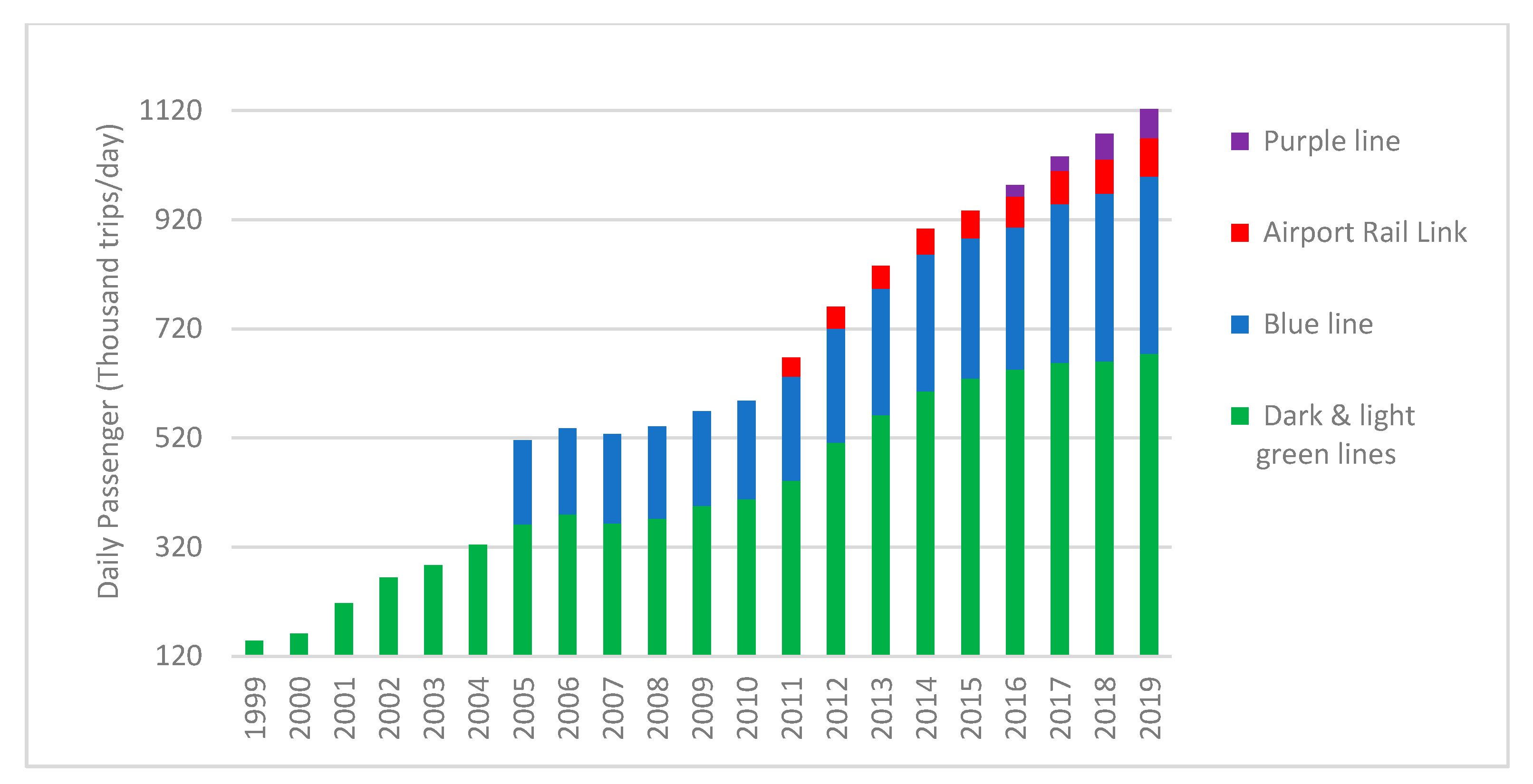

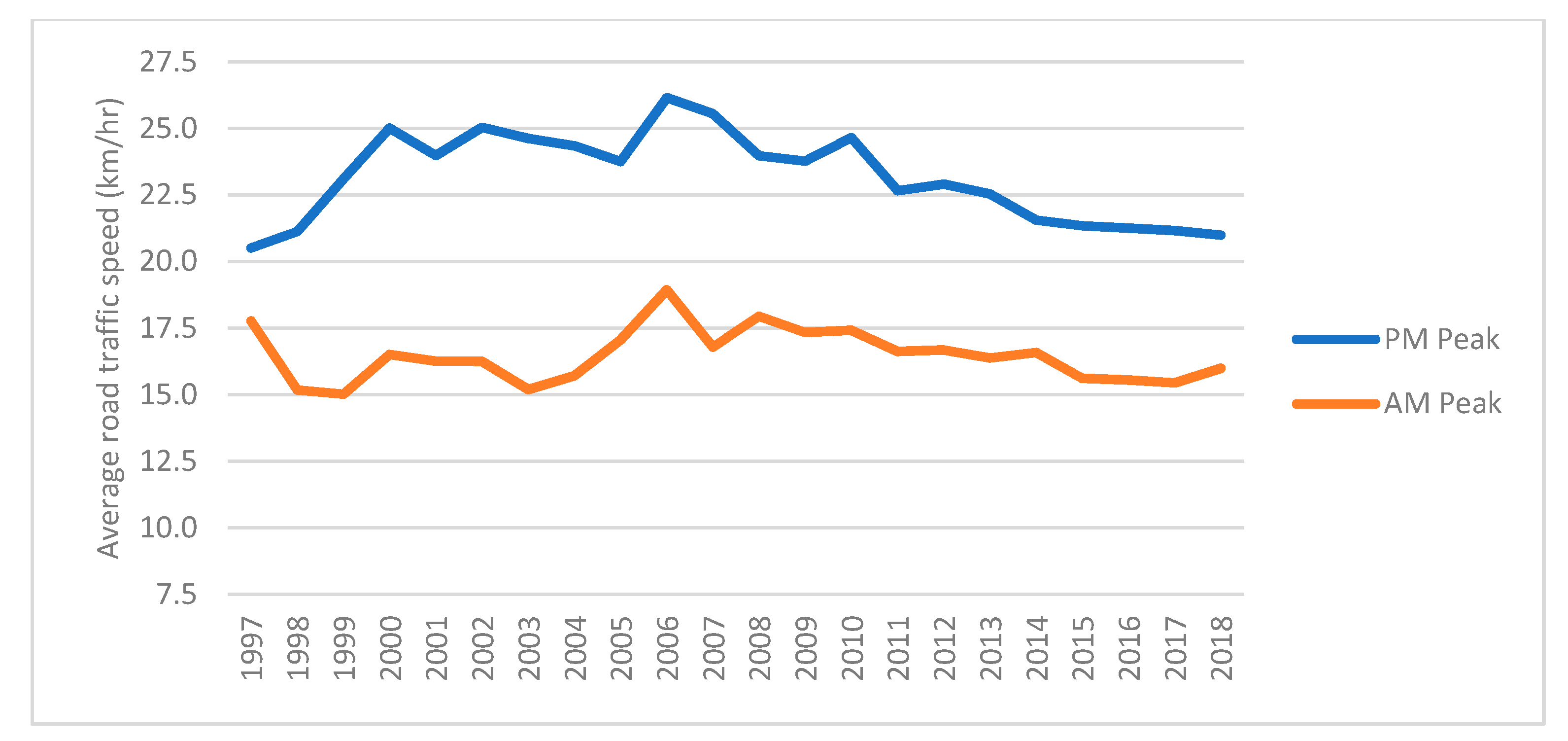
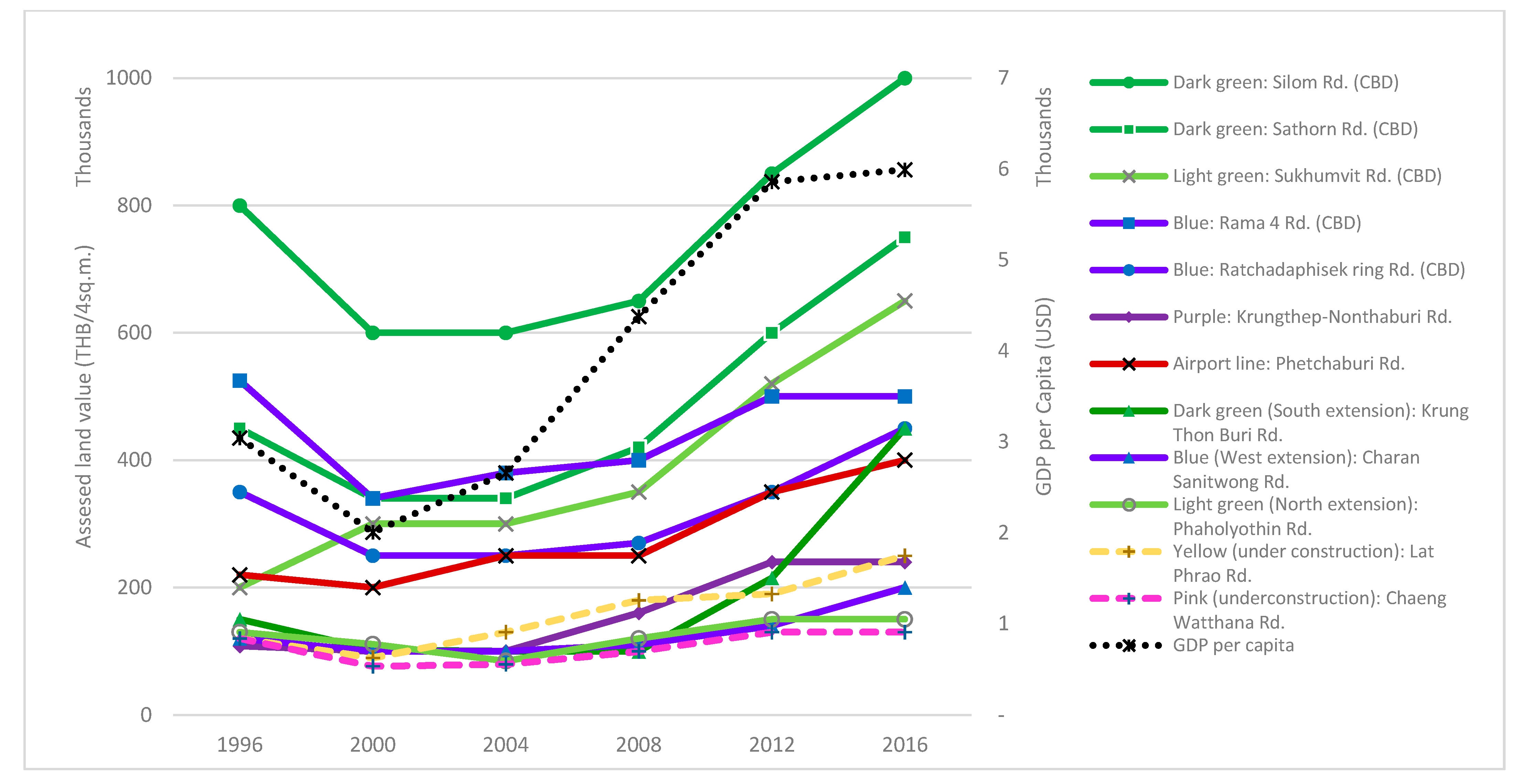
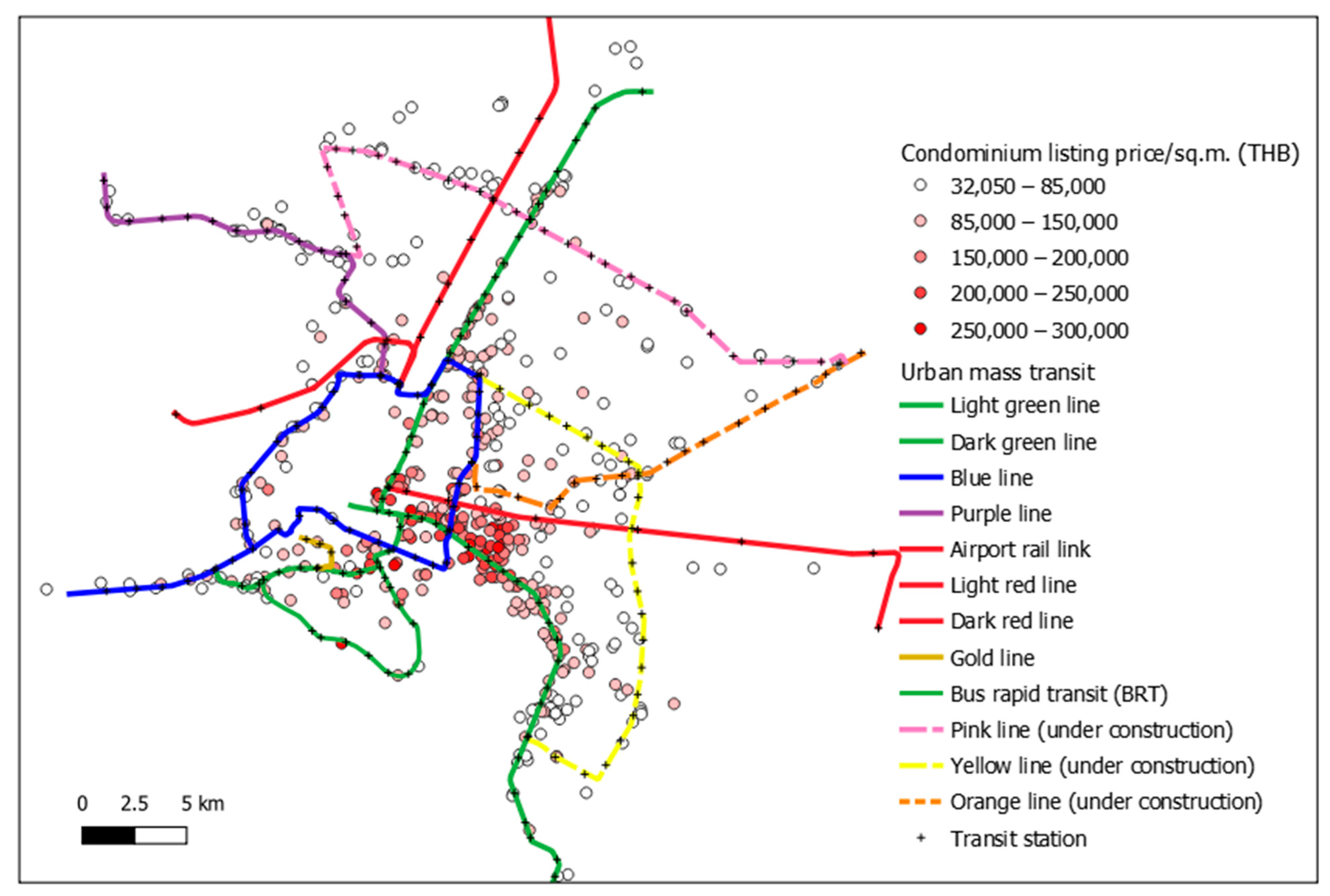
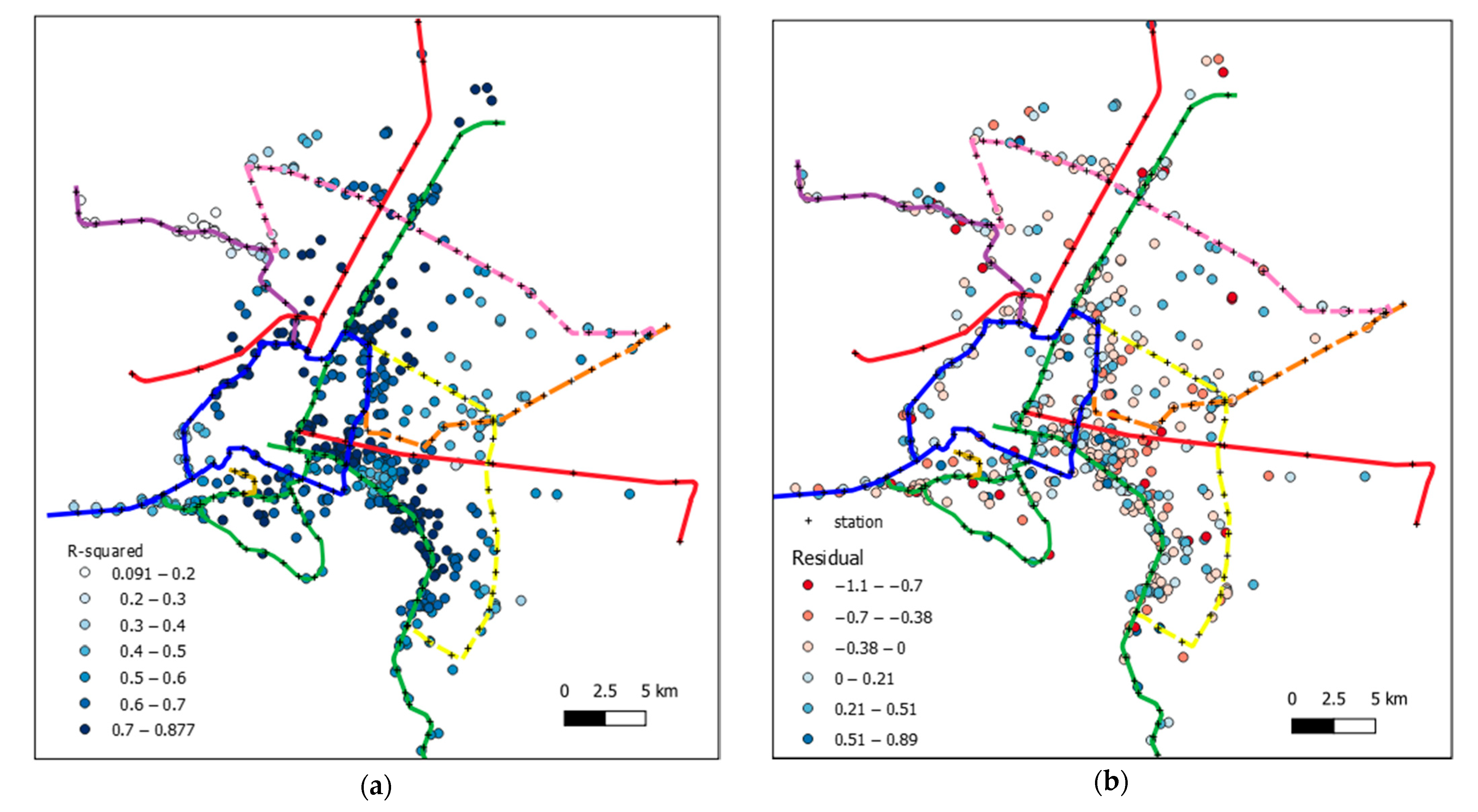
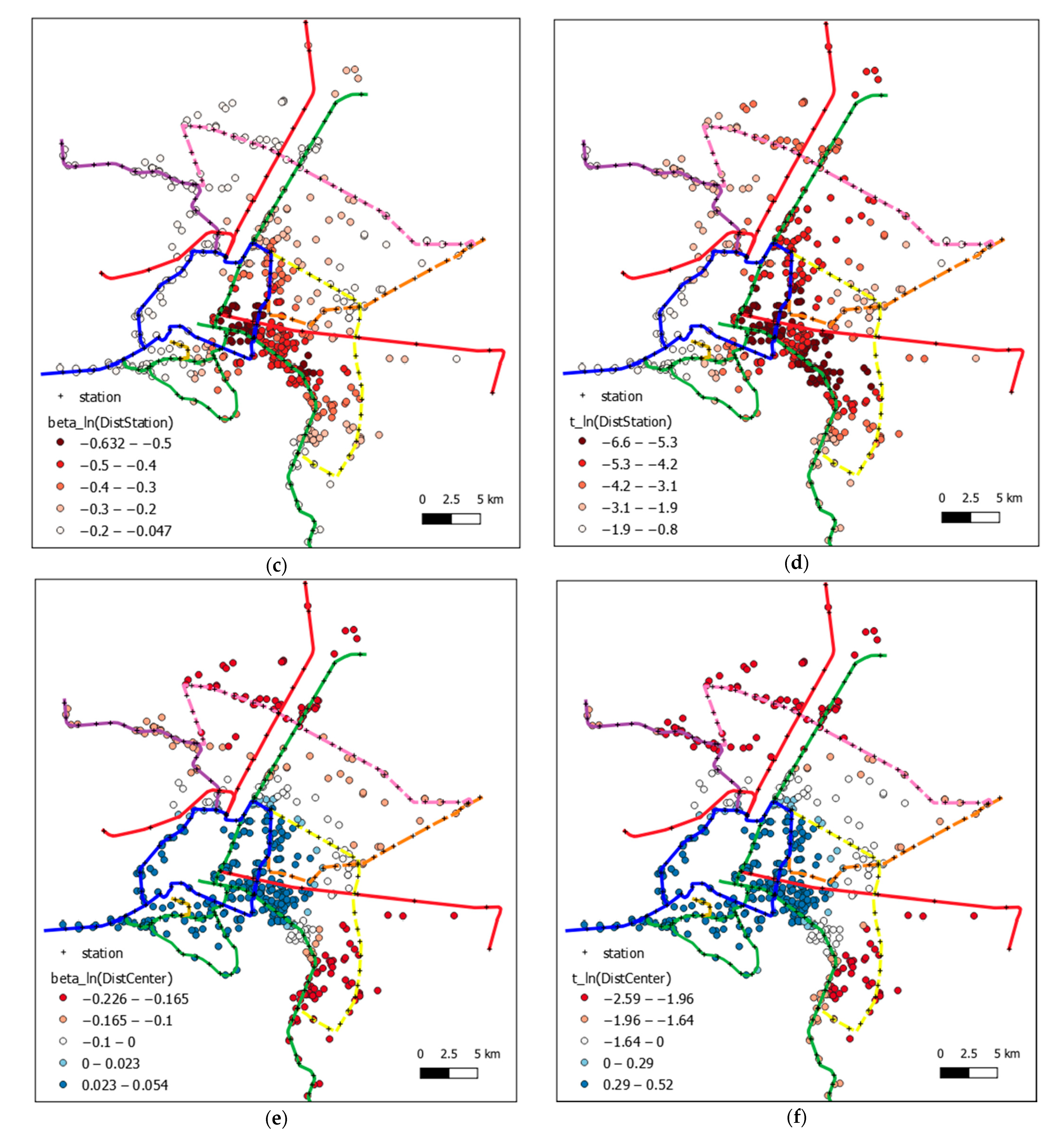
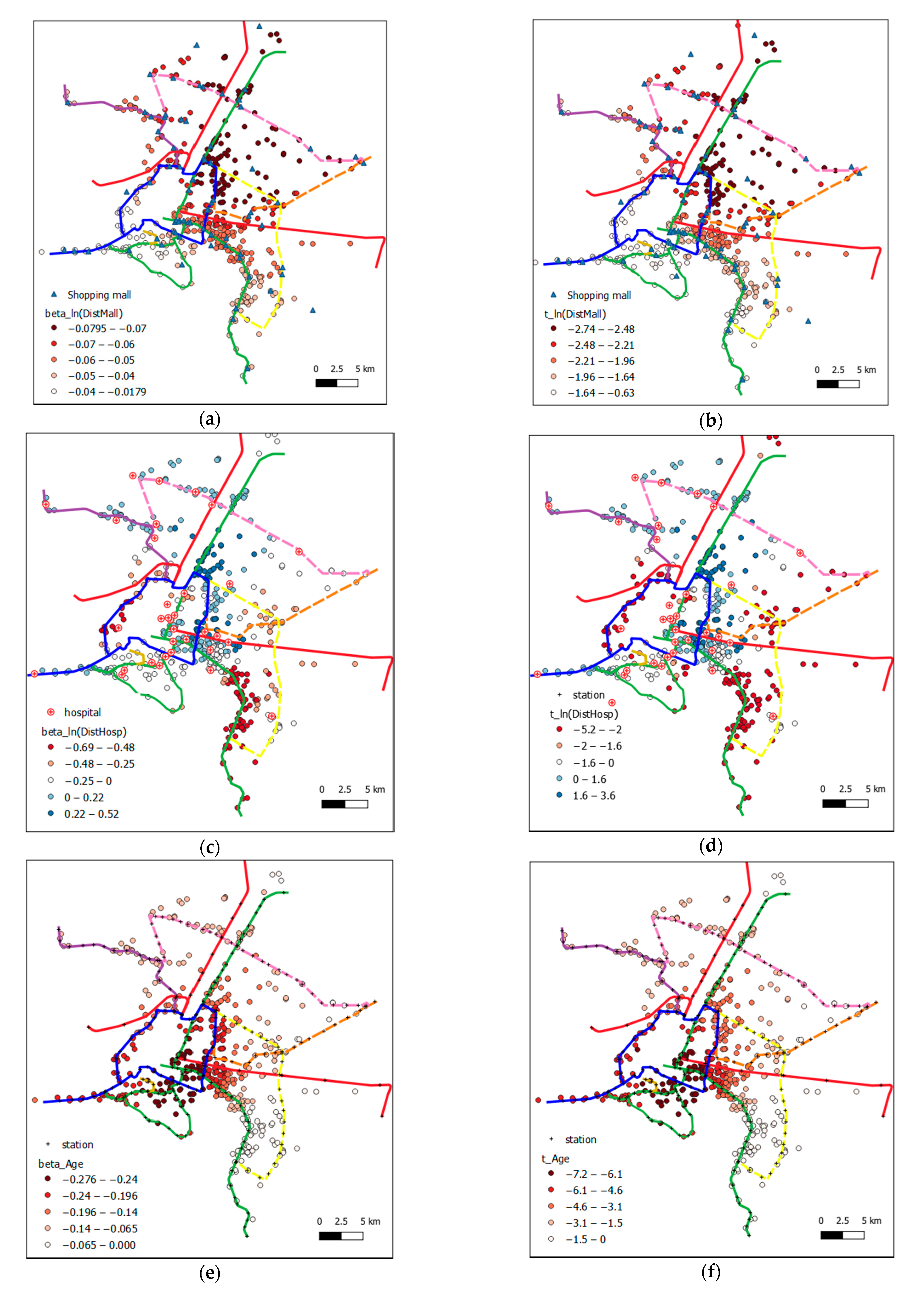
| Year | Study/Plan | Summary |
|---|---|---|
| 1972 | The Bangkok Transport Study | Highway and rail transit development. |
| 1994 | The Mass Rapid Transit System Master Plan (MTMP) | Rail transit development during 1995–2011 (135 km). |
| 1996 | The Conceptual Mass Rapid Transit Implementation Plan (CTMP) | MTMP adapted version (179 km). |
| 1998 | The Feeder Transit System Study | Additional 11 LRT and monorail projects (206 km). |
| 2000 | The Urban Rail Transportation Master Plan (URMAP) | Rail transit network development in BMR in 20 years (375 km). |
| 2004 | The Bangkok Mass Transit Implementation Plan (BMT) | The 1st phase development of 7 lines (291 km), expected to complete by 2009. |
| 2006 | 10 Lines of Mass Transit Network | BMT adapted version, 10 lines (365.5 km). |
| 2007 | 5 Urgent Mass Transit Lines | High priority urban railway lines, 5 lines (135 km). |
| 2008 | Concept of Mass Transit Network | Extension to the suburbs, 9 lines (311 km). |
| 2010 | Mass Rapid Transit Master Plan (M-Map) | Urban railway development during 2010 to 2029, 12 lines (509 km). |
| Ongoing | The Second Mass Rapid Transit Master Plan (M-Map2) | A study being carried out in cooperation with JICA. |
| Line | System | Section | Year Opened | Distance (km) | Ridership (Passengers/Day) | |
|---|---|---|---|---|---|---|
| Forecasted 2021 | Actual 2021 | |||||
| Dark Green | Heavy rail | Initial section | 1999 | 6.5 | 227,000 | 675,000 |
| South extension 1 | 2009 | 7.5 | 74,000 | |||
| South extension 2 | 2013 | 56,000 | ||||
| Light Green | Heavy rail | Initial | 1999 | 17 | 550,000 | |
| East extension 1 | 2011 | 5.3 | 73,000 | |||
| East extension 2 | 2018 | 13 | 83,000 | |||
| North extension 1 | 2019 | 19 | 134,000 | |||
| North extension 2 | 2020 | 46,000 | ||||
| Blue | Heavy rail | Initial | 2004 | 20 | 539,000 | 332,356 |
| South extension | 2019 | 14 | 206,000 | |||
| West extension | 2019 | 13 | 229,000 | |||
| Airport rail link | Heavy rail | East section | 2010 | 28.5 | 125,000 | 70,729 |
| Purple | Heavy rail | North section | 2016 | 23 | 151,000 | 59,466 |
| Dark Red | Heavy rail | North section | 2021 | 26 | 239,000 | * |
| Light Red | Heavy rail | West section 1 | 2021 | 15 | 98,000 | * |
| Pink | Monorail | Full line | (2022) | 34.5 | 199,054 | ** |
| Yellow | Monorail | Full line | (2022) | 30.4 | 195,000 | ** |
| Orange | Heavy rail | East section | (2024) | 21.2 | 170,000 | ** |
| Data Items | Unit | Mean | Std. Dev. | Min. | Max. |
|---|---|---|---|---|---|
| Representative listing price | Thai Baht (THB) | 4,916,129 | 3,741,751 | 899,000 | 21,500,000 |
| Representative listing price per sq.m. | Thai Baht (THB) | 113,626 | 56,861 | 32,050 | 300,000 |
| Floor area | Square meter | 40.96 | 18.59 | 21.70 | 223.00 |
| Age of the building | Month | 25.06 | 28.17 | 0.00 | 248.00 |
| Building category (dummy) | Dichotomous (>8 stories = 1) | 0.49 | 0.50 | 0.00 | 1.00 |
| Distance to the city center (linear) | Kilometer | 9.51 | 5.19 | 0.77 | 26.38 |
| Distance to the nearest station (linear) | Kilometer | 0.69 | 0.56 | 0.01 | 2.95 |
| Distance to the nearest station (network) | Kilometer | 1.06 | 0.76 | 0.01 | 3.97 |
| Distance to the nearest shopping mall (linear) | Kilometer | 1.21 | 0.91 | 0.02 | 8.58 |
| Distance to the nearest hospital (linear) | Kilometer | 2.41 | 1.86 | 0.07 | 10.91 |
| Distance to the nearest university (linear) | Kilometer | 3.60 | 2.63 | 0.08 | 15.21 |
| Variables | Unstandardized Coefficient | Standard Error | Standardized Coefficient | t-Value | VIF |
|---|---|---|---|---|---|
| Constant | 11.613 | 0.186 | 62.289 ** | ||
| ln(AreaSqM) | 0.203 | 0.047 | 0.144 | 4.361 ** | 1.359 |
| Highrise | 0.094 | 0.030 | 0.101 | 3.169 ** | 1.267 |
| Age | −0.003 | 0.001 | −0.210 | −6.892 ** | 1.151 |
| ln(DistCenter) | −0.356 | 0.027 | −0.500 | −13.075 ** | 1.818 |
| ln(DistStation) | −0.062 | 0.018 | −0.110 | −3.381 ** | 1.316 |
| ln(DistMall) | −0.064 | 0.018 | −0.113 | −3.571 ** | 1.243 |
| ln(DistHosp) | −0.056 | 0.018 | −0.104 | −3.077 ** | 1.426 |
| ln(DistUniv) | −0.030 | 0.020 | −0.049 | −1.533 | 1.247 |
| OLS | GWR | MGWR | |
|---|---|---|---|
| Residual sum of squares | 207.046 | 77.361 | 74.016 |
| Log-likelihood | −494.718 | −242.697 | −231.382 |
| AIC | 1007.436 | 693.560 | 656.669 |
| AICc | 1009.875 | 747.318 | 702.542 |
| R2 | 0.596 | 0.849 | 0.855 |
| Adj.R2 | 0.589 | 0.811 | 0.822 |
| Variables | Bandwidth | Local Coefficients | ||||
|---|---|---|---|---|---|---|
| Mean | Std. Dev. | Min | Median | Max | ||
| Constant | 44 | 0.311 | 0.655 | −0.701 | 0.193 | 1.577 |
| ln(AreaSqM) | 103 | 0.04 | 0.062 | −0.114 | 0.029 | 0.193 |
| Highrise | 92 | 0.135 | 0.104 | −0.068 | 0.123 | 0.368 |
| Age | 197 | −0.154 | 0.08 | −0.277 | −0.173 | −0.003 |
| ln(DistCenter) | 153 | −0.272 | 0.351 | −1.111 | −0.104 | 0.028 |
| ln(DistStation) | 98 | −0.276 | 0.145 | −0.626 | −0.267 | −0.043 |
| ln(DistMall) | 478 | −0.054 | 0.014 | −0.079 | −0.055 | −0.011 |
| ln(DistHosp) | 48 | −0.062 | 0.269 | −0.68 | −0.037 | 0.472 |
| ln(DistUniv) | 155 | 0.073 | 0.092 | −0.135 | 0.082 | 0.272 |
| Elasticity | Area | Rail line, Section (Years in Service) | Approximate Increased Property Value for Each 100 m Station Proximity |
|---|---|---|---|
| >0.5 | Interchange station in city center & city center | Light green, initial section (22 years); Blue, initial section (17 years) | >6650 THB/sq.m. (>200 USD/sq.m.) |
| 0.4–0.49 | Central business district, commercial | Light green, initial section (22 years); Dark green, initial section (22 years); Blue, initial section (17 years) | 5320–6650 THB/sq.m. (160–200 USD/sq.m.) |
| 0.3–0.39 | High-density residential | 3990–5320 THB/sq.m. (120–160 USD/sq.m.) | |
| 0.2–0.29 | Medium-density residential | Dark green, south extension 2 (8 years); Light green, inner north extension (3 years) | 2660–3990 THB/sq.m. (80–120 USD/sq.m.) |
| <0.2 | Medium-to-low density residential | Purple, initial section (5 years); Light green, north extension 2 (3 years); Light green, south extension 2 (3 years); Blue, west extension (3 years); Pink, yellow, orange (under construction) | <2660 Baht/sq.m. (<80 USD/sq.m.) |
Publisher’s Note: MDPI stays neutral with regard to jurisdictional claims in published maps and institutional affiliations. |
© 2021 by the authors. Licensee MDPI, Basel, Switzerland. This article is an open access article distributed under the terms and conditions of the Creative Commons Attribution (CC BY) license (https://creativecommons.org/licenses/by/4.0/).
Share and Cite
Vichiensan, V.; Wasuntarasook, V.; Hayashi, Y.; Kii, M.; Prakayaphun, T. Urban Rail Transit in Bangkok: Chronological Development Review and Impact on Residential Property Value. Sustainability 2022, 14, 284. https://doi.org/10.3390/su14010284
Vichiensan V, Wasuntarasook V, Hayashi Y, Kii M, Prakayaphun T. Urban Rail Transit in Bangkok: Chronological Development Review and Impact on Residential Property Value. Sustainability. 2022; 14(1):284. https://doi.org/10.3390/su14010284
Chicago/Turabian StyleVichiensan, Varameth, Vasinee Wasuntarasook, Yoshitsugu Hayashi, Masanobu Kii, and Titipakorn Prakayaphun. 2022. "Urban Rail Transit in Bangkok: Chronological Development Review and Impact on Residential Property Value" Sustainability 14, no. 1: 284. https://doi.org/10.3390/su14010284
APA StyleVichiensan, V., Wasuntarasook, V., Hayashi, Y., Kii, M., & Prakayaphun, T. (2022). Urban Rail Transit in Bangkok: Chronological Development Review and Impact on Residential Property Value. Sustainability, 14(1), 284. https://doi.org/10.3390/su14010284






